Solar is simple, but like many industries it has its own language. Let me decipher the terminology to help when you’re learning about solar for your home or business.
AC (Alternating Current)
The form of electricity used in American homes and businesses. Homes are typically 120 and 240 volt, and businesses typically use 208, 217, or 480 volts.
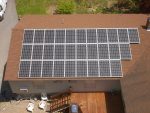 Array
Array
A fancy name for all of the solar panels in your system, plus the wiring that connects them to each other and to your property’s electrical system.
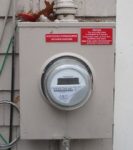 Bi-Directional Meter
Bi-Directional Meter
A variation of a net meter. What it displays can vary by manufacturer, but in general it has different displays for (a) energy you’ve sent into the grid, and (b) energy provided to you by your utility.
Cell
The basic unit of a solar panel. The cell is a thin silicon wafer with electrical conductors attached. Light shining on the cells causes electrons to move (electricity). Typically a panel will have 60 to 100 of these cells wired in series.
DC (Direct Current)
The form of electricity produced by solar panels. It must be converted into AC electricity to be used in your home or business.
Dual Meter
In Rhode Island, customers signing up for the REG program will have two separate meters – one that registers how much energy your solar has produced, and a regular electric meter that tracks how much energy you’ve taken from the grid. The difference between dual metering and bi-directional metering is that dual metering records all of the solar energy you produce, while bi-directional does not record solar that you use when it’s produced. It only records the extra solar you don’t use immediately and thus is sent into the grid.
Efficiency
The percentage of the sun’s energy hitting the panel that is converted to electricity — a typical panel is about 16%. The high efficiency panels we sell are 22% efficient.
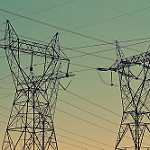 Grid
Grid
The network of utility power lines that brings electricity to your property. Your solar energy system connects to the grid to allow net metering.
Kilowatt (kW)
1,000 watts (See definition of watts below.)
Kilowatt-hour (kWh)
This refers to two things in the solar world: (1) Unit of measure for the amount of electrical energy consumed. Your electric bill states how many kilowatt-hours you used in the last month. (2) Unit of measure for the amount of electrical energy produced by your solar energy system. The meter we install with your solar system tells you how many kilowatt-hours your panels have produced.
Micro-Inverter
A piece of equipment that converts electricity from DC to AC. These are installed underneath each solar panel.
Net Meter
A net meter is the piece of equipment the utility installs for you in conjunction with your solar installation. Unlike traditional utility meters, a net meter counts up and down. It displays the “net usage” – the difference between how much solar electricity you generated at your property, and how much electricity you took from the utility grid.
Net Metering
If your solar produces more electricity during the day than you use – let’s say you’re at work – the electricity goes into the grid for other people to use. You essentially get a “credit” for that excess electricity. Then, when you get home and want to cook or watch TV but your solar is sleeping, the utility sends you electricity that is paid for with your “credits”. That is net metering. It’s a bit like rollover minutes on a cell phone plan.
The state’s investor-owned utilities must offer net metering. Municipal utilities are not obligated to offer net metering, but may do so voluntarily. Muni’s get to choose how much to credit you. Some provide “full retail net metering” where the credit is the same amount as the price you pay per kilowatt-hour of electricity. Some provide “wholesale” which is the rate they buy power at from large producers. And some don’t provide anything at all.
Photovoltaics (PV)
The original, more confusing, and harder to say name for solar electric.
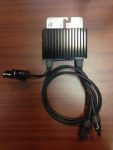 Power Optimizer
Power Optimizer
The ultimate in solar power inverter technology, IMHO. The optimizer is a doohickey we install underneath each solar panel. It maximizes the amount of energy each panel can produce.
Renewable Energy
Energy that comes from a source that renews itself or is infinite in supply. Includes solar electric and solar thermal (hot water), wind, hydro power, tidal power, biomass and geothermal.
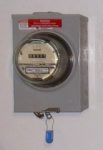 Revenue Grade Meter
Revenue Grade Meter
Also, called a “production meter,” this looks like a traditional utility meter. It tracks your total solar production over time, and is considered the most accurate solar meter. We usually install these next to your inverter.
Solar Module or Solar Panel
The piece of equipment that captures the sun for you and converts it into electricity. A collection of solar cells makes up a panel or module. We use these terms interchangeably. A bunch of panels together makes up your array.
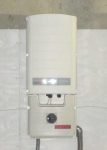 String Inverter
String Inverter
A piece of equipment that converts electricity from DC to AC so it can be used at your property. We usually install this in your garage or basement, usually in conjunction with optimizers under each panel.
Watt
A unit of measure for power. Solar panels and systems are rated in watts (or kilowatts). This rating is the peak amount of power the array can produce at any instant. Watts produced or used over time equals energy.
If you liked this article, you might also enjoy:
- How Solar Benefits All, and is Accessible to All
- Back to Basics: Energy Efficiency Explained
- STC vs. PTC: Why Solar Panel Testing Matters


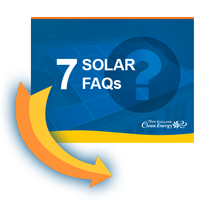 Download our 7 FAQs
Download our 7 FAQs


No comments yet. You should be kind and add one!
The comments are closed.